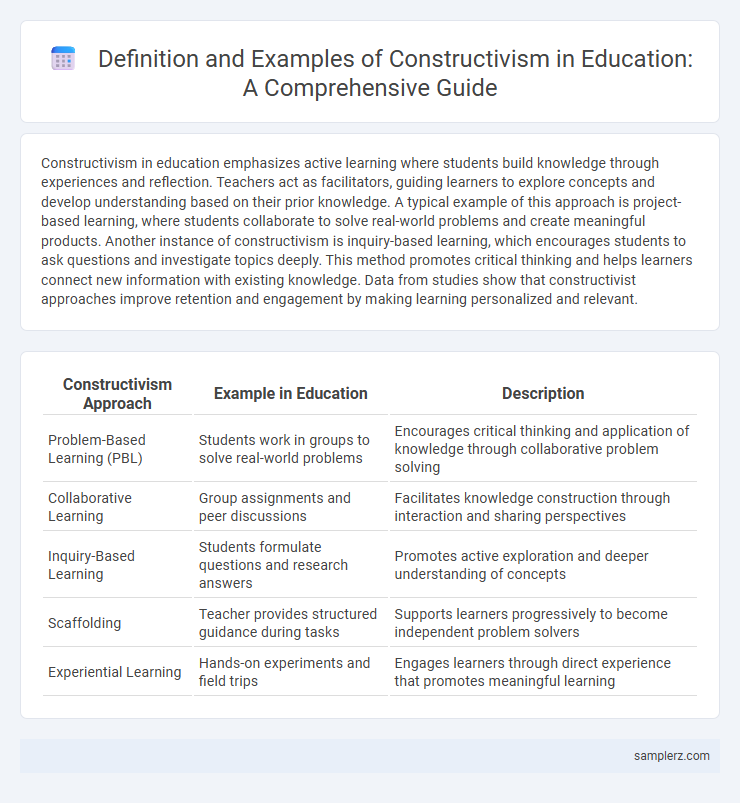Constructivism in education emphasizes active learning where students build knowledge through experiences and reflection. Teachers act as facilitators, guiding learners to explore concepts and develop understanding based on their prior knowledge. A typical example of this approach is project-based learning, where students collaborate to solve real-world problems and create meaningful products. Another instance of constructivism is inquiry-based learning, which encourages students to ask questions and investigate topics deeply. This method promotes critical thinking and helps learners connect new information with existing knowledge. Data from studies show that constructivist approaches improve retention and engagement by making learning personalized and relevant.
Table of Comparison
| Constructivism Approach | Example in Education | Description |
|---|---|---|
| Problem-Based Learning (PBL) | Students work in groups to solve real-world problems | Encourages critical thinking and application of knowledge through collaborative problem solving |
| Collaborative Learning | Group assignments and peer discussions | Facilitates knowledge construction through interaction and sharing perspectives |
| Inquiry-Based Learning | Students formulate questions and research answers | Promotes active exploration and deeper understanding of concepts |
| Scaffolding | Teacher provides structured guidance during tasks | Supports learners progressively to become independent problem solvers |
| Experiential Learning | Hands-on experiments and field trips | Engages learners through direct experience that promotes meaningful learning |
Real-World Problem Solving in the Classroom
Constructivism in education emphasizes students actively constructing knowledge through hands-on experiences and collaboration, with real-world problem solving serving as a key application. Teachers design authentic tasks that require learners to analyze, hypothesize, and test solutions related to actual societal or scientific challenges. This approach fosters critical thinking, metacognition, and the ability to transfer skills beyond the classroom setting.
Collaborative Learning Activities
Collaborative learning activities exemplify constructivism by encouraging students to actively engage in knowledge construction through group interactions and problem-solving. This approach fosters critical thinking, communication skills, and deeper understanding as learners share diverse perspectives and negotiate meaning together. Research shows that collaborative learning enhances retention and application of concepts, aligning with constructivist principles that knowledge is co-created within social contexts.
Project-Based Learning Experiences
Project-Based Learning (PBL) exemplifies constructivism by engaging students in real-world problems where they actively construct knowledge through investigation and collaboration. This approach fosters critical thinking, creativity, and deeper understanding as learners connect new information with prior experiences. Schools implementing PBL often report enhanced student motivation and improved academic outcomes across STEM and humanities subjects.
Student-Led Inquiry and Exploration
Student-Led Inquiry and Exploration embodies constructivist principles by empowering learners to actively engage with subject matter through questions they generate themselves. This approach emphasizes critical thinking and problem-solving skills, allowing students to build knowledge based on personal experiences and collaborative dialogue. Classroom environments adopting this method often utilize project-based learning and open-ended investigations to foster deeper understanding and intrinsic motivation.
Reflective Journals and Self-Assessment
Reflective journals encourage students to analyze their learning experiences, fostering deeper understanding through personal insight and critical thinking. Self-assessment promotes active learner engagement by enabling individuals to evaluate their progress and identify areas for improvement. Both methods align with constructivist principles by supporting knowledge construction through reflection and self-directed evaluation.
Use of Scaffolding and Zone of Proximal Development
Constructivism in education emphasizes the use of scaffolding, where teachers provide temporary support to students as they develop new skills within their Zone of Proximal Development (ZPD), the gap between what learners can do independently and what they can achieve with guidance. This approach fosters active learning by gradually reducing assistance, encouraging students to internalize knowledge and build critical thinking abilities. Effective scaffolding techniques include guided questioning, modeling tasks, and interactive feedback, all designed to promote deeper cognitive development tailored to individual learner needs.
Hands-On Experiments and Simulations
Hands-on experiments and simulations exemplify constructivism by actively engaging students in learning through direct experience and exploration. These methods encourage learners to build knowledge by experimenting, observing outcomes, and reflecting on processes, fostering deeper conceptual understanding. Educational tools such as virtual labs and interactive models support this approach by allowing iterative problem-solving in real-world contexts.
Integration of Prior Knowledge
Constructivism in education emphasizes the integration of prior knowledge by encouraging students to connect new information with their existing understanding, fostering deeper learning. Teachers design activities that activate students' background experiences, such as project-based learning or problem-solving tasks, enabling meaningful knowledge construction. This approach enhances critical thinking and retention by building on familiar concepts while promoting active engagement in the learning process.
Formative Assessment Through Discussion
Formative assessment through discussion exemplifies constructivism by actively engaging students in meaning-making and knowledge construction during learning. This approach encourages learners to articulate their understanding, ask questions, and collaboratively refine ideas in real-time, facilitating deeper comprehension. Teachers act as facilitators, guiding dialogue to reveal misconceptions and promote metacognitive skills, essential for personalized learning paths.
Technology-Enhanced Constructivist Lessons
Technology-enhanced constructivist lessons integrate interactive simulations, digital collaboration tools, and multimedia resources to foster active student engagement and personalized learning experiences. Virtual labs and educational software facilitate inquiry-based learning by allowing students to explore concepts through experimentation and problem-solving in authentic contexts. This approach promotes critical thinking and knowledge construction by enabling learners to build understanding through hands-on interaction and peer collaboration.

example of constructivism in approach Infographic
 samplerz.com
samplerz.com